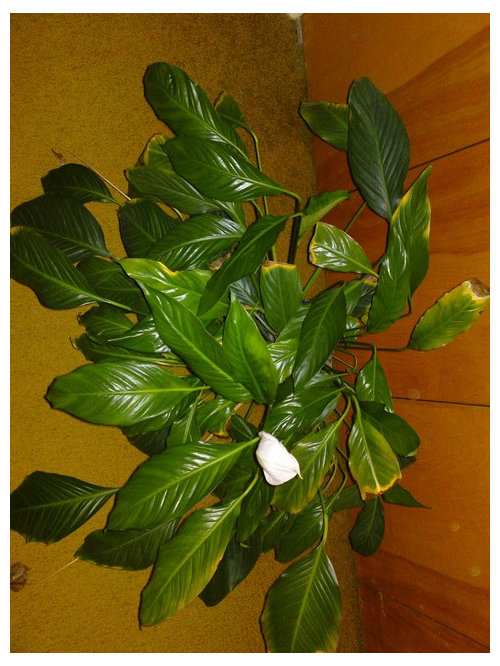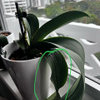I have always had a centerpiece Peace Lilly (I've replaced with fresh ones when they eventually die) that grows and grows (and yes needs repotting in the photo--but again that's a whole different story), but when its growing I use a water meter to make sure I'm not overwatering as I wait until its dry before watering it.
Someone in the garden shop like 20 years ago when I started to get these, taught me they are from South America and love a "bath" so I fill up the watering dish when I water the plant and you can watch the plant actually drink up the water rapidly.
I'm confused: I saw a You Tube video (see below for title) about how a Peace Lilly's brown leaves (and the yellow that preceeds them) is caused by overwatering-- yet if I should forget to check for dry conditions, the plant will tell me by drooping every single leaf---long before the moisture meter enters the totally dry zone-----
So I'm confused! To save the plant I water before it starts to droop... But then the constant (I always thought its just a part of owning a peace lilly that it grows well in the hothouse but in the home it has brown tips due to drafts (its not in a drafty place and pothos nearby don't have the same problem.
I saw the Houseplants #4 You Tube Video by The Ficus Wranger and also my Warneckii Dracona is brown at the tips and then it gets brown along the edges and so on.... The plant grows and puts out great new leaves, but they just don't stay like the photos in books and stores show---- so I have a dense top bunch (see photo) and rest is brown tips too..... which seems to be overwatering, but again I only obey the water meter---about once a week---but I don't water if it was cloudy and the meter says it has a few more days to go before its dry... Yet constantly brown tips that I have to cut off (two plants of four are shown in photo)...
For Marlie: Here is the double-pot as demonstrated in the You Tube (one of three identical woven pots with Draconas all similar). Photo how I got it from the store--got it as it is--second generation in the pot that's why its so small size compared to the pot--inside there is a plastic liner the size of the pot, no saucer at all! I stuffed shallow plastic one in when I repotted it in same pot after I lost the mother Dracina.
Thanks to all who read and offer advice!
Forest_of_Houseplants














forest_of_houseplantOriginal Author
forest_of_houseplantOriginal Author
Related Professionals
Ashland Landscape Architects & Landscape Designers · West Milford Landscape Architects & Landscape Designers · Carson Landscape Architects & Landscape Designers · Chattanooga Landscape Architects & Landscape Designers · Fillmore Landscape Architects & Landscape Designers · Milwaukee Landscape Architects & Landscape Designers · Buford Landscape Contractors · Springfield Landscape Contractors · Cicero Landscape Contractors · Harvey Landscape Contractors · Kahului Landscape Contractors · Mastic Beach Landscape Contractors · Pine Hills Landscape Contractors · Tigard Landscape Contractors · White Bear Lake Landscape ContractorsEmbothrium
forest_of_houseplantOriginal Author
forest_of_houseplantOriginal Author
forest_of_houseplantOriginal Author
pirate_girl
summersunlight
forest_of_houseplantOriginal Author
petrushka (7b)
pirate_girl
summersunlight
rachels_haven
tropicbreezent
petrushka (7b)
pirate_girl
summersunlight
petrushka (7b)
Carol love_the_yard (Zone 9A Jacksonville, FL)
tapla (mid-Michigan, USDA z5b-6a)
petrushka (7b)
tapla (mid-Michigan, USDA z5b-6a)
petrushka (7b)
forest_of_houseplantOriginal Author
tapla (mid-Michigan, USDA z5b-6a)